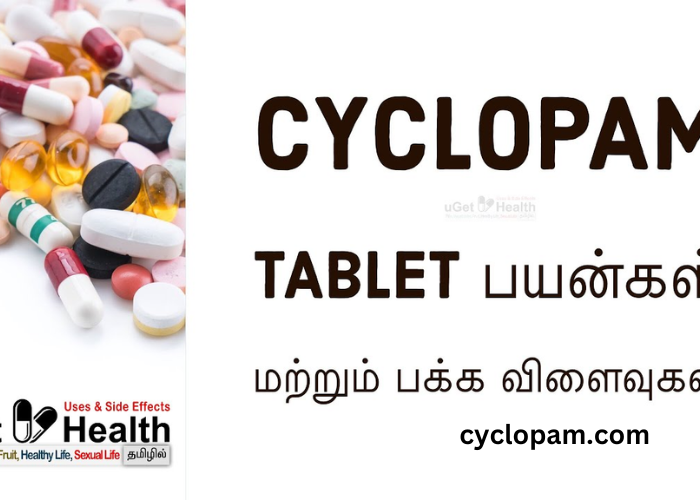Cyclopam syrup is a common medication used to address abdominal pain and digestive discomfort in children. It combines two key ingredients, Dicyclomine and Paracetamol, to provide relief from various gastrointestinal symptoms. This article will explore the uses of Cyclopam syrup, including its benefits, dosage guidelines, and safety considerations, with a focus on information available in Tamil.
What is Cyclopam Syrup?
Cyclopam syrup is designed to alleviate pain and discomfort associated with digestive issues. It combines two active ingredients:
Dicyclomine
Dicyclomine is an anticholinergic medication that works by relaxing the smooth muscles of the gastrointestinal tract. It is effective in reducing cramping and spasms.
Paracetamol
Paracetamol, also known as acetaminophen, is a widely used analgesic and antipyretic. It helps reduce pain and fever, enhancing the overall effectiveness of the syrup.
Uses of Cyclopam Syrup in Tamil
Cyclopam syrup is used to manage various gastrointestinal issues in children. Here’s a detailed look at its primary uses:
Managing Abdominal Pain
Cyclopam syrup is commonly prescribed for children experiencing abdominal pain due to conditions such as indigestion, gas, or infections. The combination of Dicyclomine and Paracetamol helps alleviate both pain and cramping.
Alleviating Gastrointestinal Spasms
The antispasmodic properties of Dicyclomine help relax the muscles in the gastrointestinal tract, reducing the severity and frequency of spasms. This can provide significant relief for children suffering from intense cramping.
Treating Fever and Discomfort
Paracetamol in Cyclopam syrup also helps reduce fever and general discomfort that may accompany digestive issues. This dual-action approach helps address both pain and associated symptoms.
Dosage Guidelines for Cyclopam Syrup
Correct dosing is crucial for the effectiveness and safety of Cyclopam syrup. Dosage recommendations should be followed precisely. Here’s a general guideline for children:
Recommended Dosage
- Typical Dose: For a 6-year-old child, the usual dosage is 5-10 ml of Cyclopam syrup, administered 2-3 times daily. Adjustments may be made based on the child’s response and medical condition.
- Maximum Dose: Adhere to the prescribed dosage to avoid potential side effects. Consult with a healthcare provider for any adjustments.
Administration Tips
- Use Proper Measuring Devices: Always use the measuring spoon or device provided to ensure accurate dosing.
- Monitor for Side Effects: Watch for any adverse reactions or side effects after administering the syrup. Consult a healthcare provider if any unusual symptoms arise.
Benefits of Cyclopam Syrup
Cyclopam syrup provides several benefits for managing abdominal pain and digestive discomfort:
Effective Pain Relief
The combination of Dicyclomine and Paracetamol offers effective relief from abdominal pain and cramping. This can greatly enhance the child’s comfort and quality of life.
Reduction of Muscle Spasms
Dicyclomine’s ability to relax smooth muscles helps in reducing the occurrence and intensity of gastrointestinal spasms, offering significant relief from cramping.
Comprehensive Treatment
Cyclopam syrup’s dual-action formula addresses both pain and muscle spasms, providing a comprehensive approach to managing digestive issues in children.
Safety Considerations and Side Effects
While Cyclopam syrup is generally safe, it is important to be aware of potential side effects and take necessary precautions:
Common Side Effects
- Drowsiness: Paracetamol can cause drowsiness in some children. Monitor the child’s activity levels and ensure they are not excessively sedated.
- Dry Mouth: Dicyclomine may cause dry mouth. Encourage the child to drink plenty of fluids to stay hydrated.
Serious Side Effects
In rare instances, more serious side effects may occur:
- Allergic Reactions: Symptoms such as rash, itching, or swelling require immediate medical attention.
- Liver Issues: Overuse of Paracetamol can affect liver function. Follow dosage recommendations to avoid potential liver damage.
Precautions
- Medical History: Inform the healthcare provider of any pre-existing medical conditions or allergies before starting Cyclopam syrup.
- Drug Interactions: Be aware of possible interactions with other medications. Consult with a healthcare provider before combining Cyclopam syrup with other treatments.
Alternatives to Cyclopam Syrup
Other treatments may be appropriate depending on the specific condition and symptoms. Consider these alternatives:
Over-the-Counter Pain Relievers
- Ibuprofen: Another option for pain and fever relief, Ibuprofen can be used as an alternative to Paracetamol. Follow dosage guidelines for children.
Dietary Adjustments
- Dietary Changes: Modifying the child’s diet, such as avoiding certain foods or increasing fiber intake, may help manage abdominal pain.
Other Medications
- Antacids: For issues related to acid reflux or indigestion, antacids may be effective. Consult with a healthcare provider for suitable alternatives.
Tips for Managing Abdominal Pain in Children
In addition to medication, consider these tips for managing abdominal pain and discomfort in children:
Maintain a Balanced Diet
- Healthy Eating: Ensure the child consumes a balanced diet rich in fiber, fruits, and vegetables to support digestive health.
Encourage Hydration
- Drink Plenty of Fluids: Ensure the child stays hydrated by drinking adequate water, which can help alleviate digestive discomfort.
Monitor Symptoms
- Track Changes: Keep a record of the child’s symptoms and response to treatment. Report any persistent issues or changes to the healthcare provider.
Consulting a Healthcare Provider
Before starting any new medication, including Cyclopam syrup, it is essential to consult a healthcare provider. They can provide personalized advice based on the child’s health history and specific needs.
Conclusion
Cyclopam syrup is a valuable tool for managing abdominal pain and digestive issues in children. With its effective combination of Dicyclomine and Paracetamol, it provides relief from pain, cramps, and discomfort.
Proper dosage and awareness of potential side effects are crucial for ensuring safety and effectiveness. By considering alternative treatments and consulting healthcare providers, parents can make informed decisions to manage their child’s digestive health and overall well-being.
